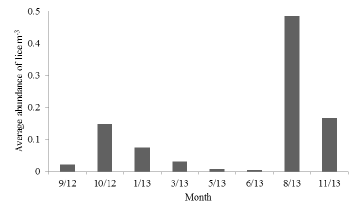Sea Lice dispersal modelling
Carried out in conjunction with Loch Duart Ltd and the Scottish Association for Marine Sciences, the Trust undertook plankton sampling within the area to provide data for the model development.
 |
The sea lice Caligus elongatus (Sea louse) and Lepeoptherius salmonis (Salmon louse) are major parasites of salmonid fish. The salmon louse most commonly infects salmon and sea trout in Sutherland waters where it feeds on the surface of the skin, which can in severe cases result in open wounds leading to secondary infections and osmoregulatory problems. In the lifecycle of the salmon louse there are three planktonic stages, two nauplii and one copepodid which is infective. Upon encounter with a host the copepodid will attach itself to the fish where it will develop through a further seven life stages (chalimus stages, preadult stages and adult). Salmon and trout smolts on their seaward migration and returning adults are the most vulnerable to infection as they pass through bays and sea lochs containing salmon farms where the lice levels might be higher than those expected naturally.
 |
There are concerns over lice abundance in relation to fish farms and the possible threats to wild salmonids. The extent of the interaction of sea lice between wild and farmed fish is not clear, with local declines in sea trout populations potentially linked to aquaculture. In conjunction with the local fish farm Loch Duart Ltd and the Scottish Association for Marine Science (SAMS), the Trust was involved in a two year project that aims to model sea lice dispersal in order to get a better understanding of the abundance and distribution of lice in the area. This data can then be used to inform management decisions for effective lice control and salmonid conservation in our sea lochs.
Plankton sampling
Starting in September 2012 for a year, plankton were sampled at twelve sites around Eddrachilles Bay. Each site was sampled every month in summer and every two months in winter, weather permitting. The plankton were collected in a conical net towed from the back of the boat at a constant speed along known transects for five minute trawls. During the analysis of the samples, all lice were identified and the numbers and planktonic life stage (nauplii and copepodid) recorded. Lice abundance is partly dependent on environmental conditions such as water temperature, as well as the time of year. Fish susceptibility also depends on its size and the length of time spent in the area, as well as the position of the sea lice in the water column.
Results
|
|
During the sampling period, there were no lice found at 2 of the sites. At the other sites, copepodids dominated the samples with nauplii found in only 13 of the 92 samples analysed. This agrees with other studies, where nauplii are routinely found at lower levels in the water column than copepodids and would not, therefore be picked up in a surface net. In addition, there was no trend apparent in the number of lice per m3 with either temperature or salinity.
The prevalence, or percentage of sites at which lice were found on each occasion, was calculated, as was the abundance. Surprisingly, prevalence was greatest during the January sample, declining with time until June before increasing towards the end of the year. Conventional wisdom would suggest that, as sea lice development is temperature dependent, there should be more around in the warmer, summer months, contrary to the findings of this study.
A similar pattern can be seen in the abundance data which shows the average number of lice at each site. The decrease in numbers of lice from October to June is not as expected, where the higher water temperatures should result in greater lice activity. There is a peak in abundance recorded in August, although this relates to large numbers of lice at a small number of sites, and is therefore still contrary to the expected.
|
|
|
|







